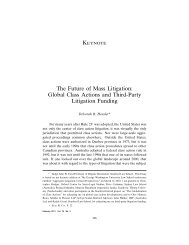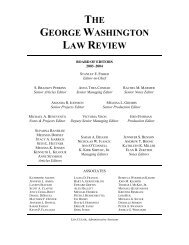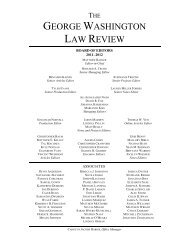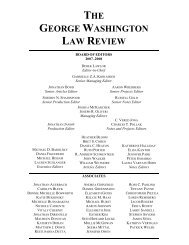View PDF - The George Washington Law Review
View PDF - The George Washington Law Review
View PDF - The George Washington Law Review
You also want an ePaper? Increase the reach of your titles
YUMPU automatically turns print PDFs into web optimized ePapers that Google loves.
872 <strong>The</strong> <strong>George</strong> <strong>Washington</strong> <strong>Law</strong> <strong>Review</strong> [Vol. 78:870<br />
<strong>The</strong> Fifth Amendment’s Takings Clause prohibits the taking of<br />
private property for public use “without just compensation.” 7 <strong>The</strong> Supreme<br />
Court has long interpreted the Takings Clause as encompassing<br />
not only physical confiscations of property, but also certain scenarios<br />
where a government regulation detrimentally affects privately owned<br />
property. 8 <strong>The</strong> Justices of the Supreme Court, along with other legal<br />
scholars, have debated whether regulatory takings doctrine should<br />
take the form of an ad hoc balancing test, an exclusive set of strict per<br />
se rules, or a combination of both, as is currently the case. 9<br />
<strong>The</strong> primary test for determining whether regulation effects a<br />
Fifth Amendment taking is the Penn Central ad hoc balancing test,<br />
which examines three factors: the regulation’s economic impact, the<br />
claimant’s distinct investment-backed expectations, and the character<br />
of the governmental action. 10 In addition to the Penn Central balancing<br />
test, the current takings doctrine includes the per se rules of Lucas<br />
and Loretto. Lucas holds that a taking ordinarily occurs 11 if the “regulation<br />
denies all economically beneficial or productive use of the<br />
land.” 12 Loretto holds that a taking ordinarily occurs 13 if the regulation<br />
causes a permanent physical occupation on the land. 14 Alongside<br />
this confusing structure existed yet another per se test that held that a<br />
taking occurred if the regulation did not substantially advance a legiti-<br />
7 U.S. CONST. amend. V.<br />
8 See infra text accompanying notes 20–22.<br />
9 See infra pp. 106–08.<br />
10 Penn Cent. Transp. Co. v. New York City, 438 U.S. 104, 124 (1978). It can be argued,<br />
however, that the Penn Central balancing test examines only two factors. In Penn Central, the<br />
Court explained that “[t]he economic impact of the regulation on the claimant and, particularly,<br />
the extent to which the regulation has interfered with distinct investment-backed expectations<br />
are, of course, relevant considerations.” Id. This may suggest that the test only consists of two<br />
factors: (1) the economic impact, in light of the distinct investment-backed expectations, and (2)<br />
the character of the governmental action. See Gary <strong>Law</strong>son, Katharine Ferguson & Guillermo<br />
A. Montero, “Oh Lord, Please Don’t Let Me Be Misunderstood!”: Rediscovering the Mathews v.<br />
Eldridge and Penn Central Frameworks, 81 NOTRE DAME L. REV. 1, 32 (2005).<br />
11 Although a taking ordinarily occurs if the per se rule is satisfied, it is not always the<br />
case, as the regulation may fall within the nuisance exception. Under this exception, compensation<br />
is not due if the prohibited use is impermissible under the “background principles” of the<br />
common law. See Lucas v. S.C. Coastal Council, 505 U.S. 1003, 1029 (1992). <strong>The</strong> Court has been<br />
hesitant “to find a taking when the State merely restrains uses of property that are tantamount<br />
to public nuisances.” Keystone Bituminous Coal Ass’n v. DeBenedictis, 480 U.S. 470, 491<br />
(1987). It may be argued that the nuisance exception is actually a third per se rule, in that it acts<br />
as a categorical exemption. <strong>The</strong>re is thus automatically no taking and no just compensation<br />
awarded if the nuisance exception applies. See DAVID A. DANA & THOMAS W. MERRILL, PROP-<br />
ERTY: TAKINGS 111 (2002).<br />
12 Lucas, 505 U.S. at 1015.<br />
13 See DANA & MERRILL, supra note 11, at 95.<br />
14 See Loretto v. Teleprompter Manhattan CATV Corp., 458 U.S. 419, 426 (1982).









